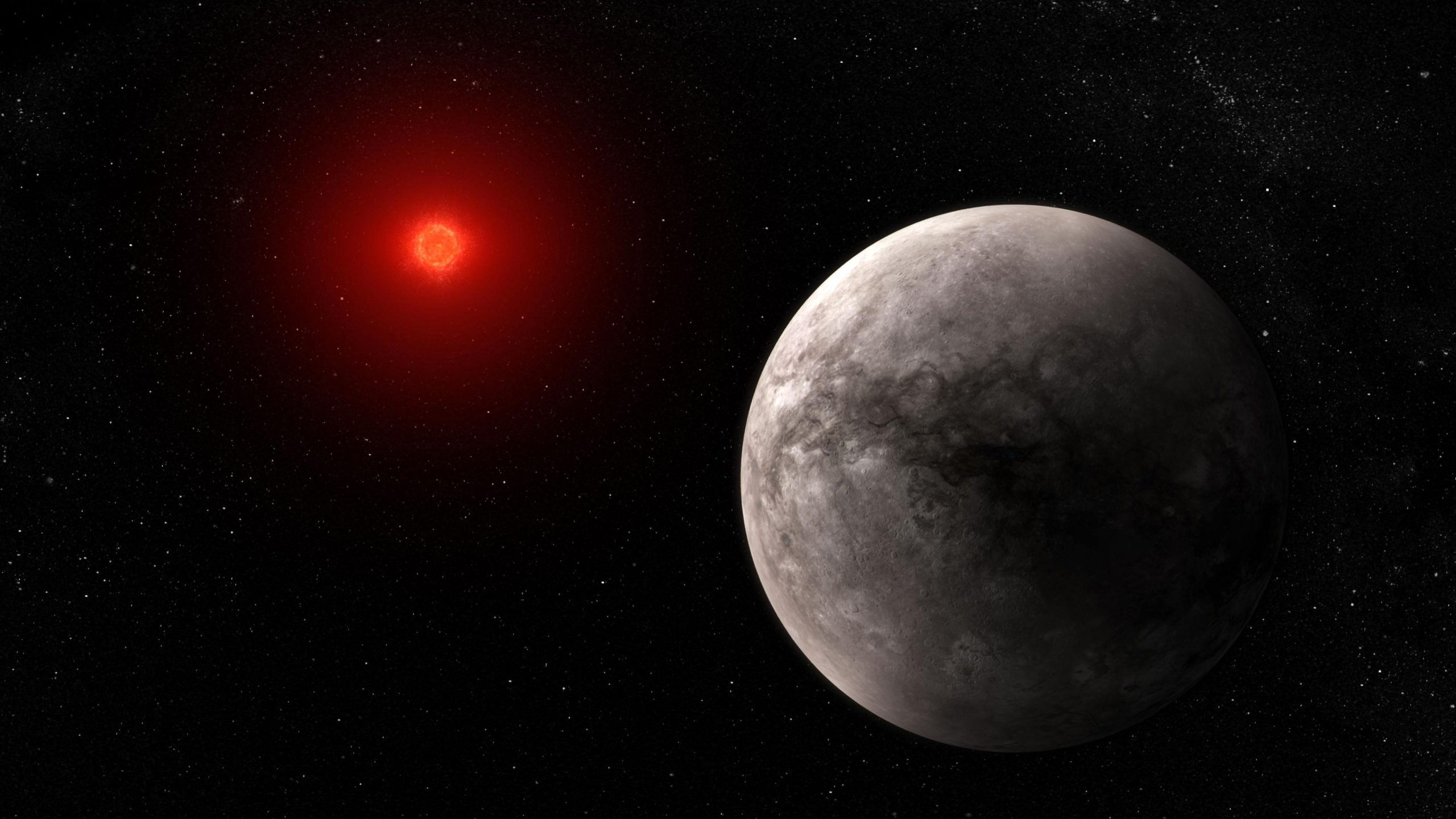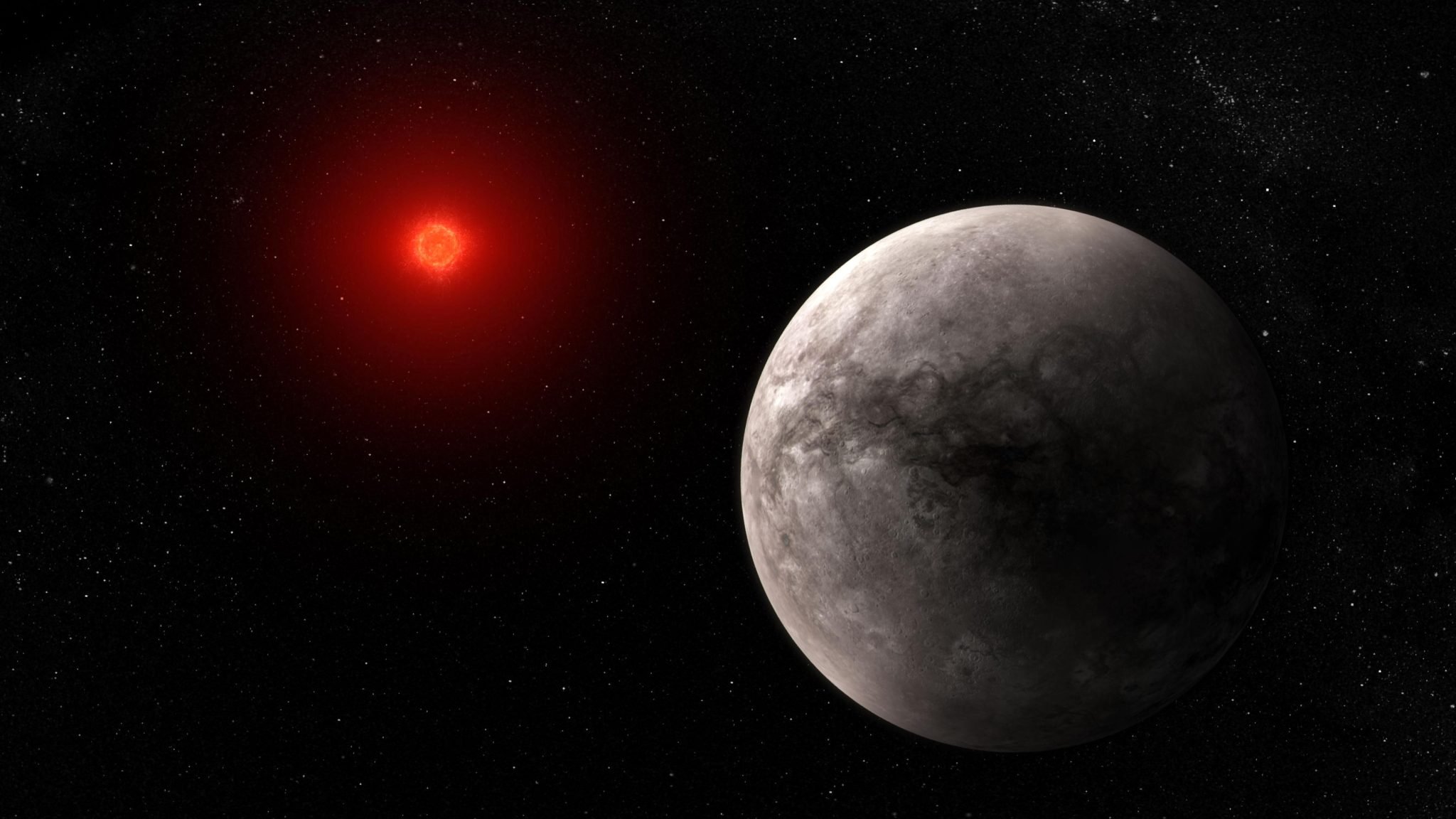

Ez az illusztráció bemutatja, hogyan nézhet ki a forró, sziklás TRAPPIST-1 b bolygó e munka alapján. A TRAPPIST-1 b, a TRAPPIST-1 rendszer hét ismert bolygója közül a legbelső, 0,011 AU távolságra kering a csillaga körül, és mindössze 1,51 földi nap alatt tesz meg egy kört. A TRAPPIST-1 b valamivel nagyobb, mint a Földé, de körülbelül azonos sűrűségű, ami azt jelzi, hogy sziklás összetételűnek kell lennie. Webb mérése a TRAPPIST-1 b által kibocsátott középső infravörös fényre azt jelzi, hogy a bolygónak nincs jelentős légköre. A TRAPPIST-1 egy rendkívül hideg vörös törpe (M törpe), amelynek hőmérséklete mindössze 2566 K, tömege pedig 0,09-szerese a Napénak.
Ez az illusztráció a Web Mid-Infrared Instrument (MIRI) által gyűjtött új adatokon, valamint korábbi megfigyeléseken alapul.
más földi és űrtávcsövekről. Webb nem készített képeket a bolygóról.
Köszönetnyilvánítás: Illusztráció: NASA, ESA, CSA, Joseph Olmsted (STScI), tudomány: Thomas B.
A TRAPPIST-1 b-ből érkező infravörös fény mennyisége azt jelzi, hogy a bolygón nincs jelentős légkör.
Óriási, érintésmentes hőmérőként működik,[{” attribute=””>NASA’s James Webb Space Telescope has successfully measured heat radiating from the innermost of the seven rocky planets orbiting TRAPPIST-1, a cool red dwarf star 40 light-years from Earth. With a dayside temperature of 450 degrees Fahrenheit, the planet is just about perfect for baking pizza. But with no atmosphere to speak of, it may not be the best spot to dine out. The result is the first from a comprehensive set of Webb studies of the TRAPPIST-1 system, and marks an important step in determining whether planets orbiting tiny but violent red dwarfs, the most common type of star in the Galaxy, can sustain atmospheres needed to support life.

Comparison of the dayside temperature of TRAPPIST-1 b as measured using Webb’s Mid-Infrared Instrument (MIRI) to computer models showing what the temperature would be under various conditions. The models take into account the known properties of the system, including the temperature of the star and the planet’s orbital distance. The temperature of the dayside of Mercury is also shown for reference.
The dayside brightness of TRAPPIST-1 b at 15 microns corresponds to a temperature of about 500 kelvins (roughly 450 degrees Fahrenheit). This is consistent with the temperature assuming the planet is tidally locked (one side facing the star at all times), with a dark-colored surface, no atmosphere, and no redistribution of heat from the dayside to the nightside.
If the heat energy from the star were distributed evenly around the planet (for example, by a circulating carbon dioxide-free atmosphere), the temperature at 15 microns would be 400 kelvins (260 degrees Fahrenheit). If the atmosphere had a substantial amount of carbon dioxide, it would emit even less 15-micron light and would appear to be even cooler.
Although TRAPPIST-1 b is hot by Earth standards, it is cooler than the dayside of Mercury, which consists of bare rock and no significant atmosphere. Mercury receives about 1.6 times more energy from the Sun than TRAPPIST-1 b does from its star. Credit: Illustration: NASA, ESA, CSA, Joseph Olmsted (STScI), Science: Thomas P. Greene (NASA Ames), Taylor Bell (BAERI), Elsa Ducrot (CEA), Pierre-Olivier Lagage (CEA)
NASA’s Webb Measures the Temperature of a Rocky Exoplanet
An international team of researchers has used NASA’s James Webb Space Telescope to measure the temperature of the rocky exoplanet TRAPPIST-1 b. The measurement is based on the planet’s thermal emission: heat energy given off in the form of infrared light detected by Webb’s Mid-Infrared Instrument (MIRI). The result indicates that the planet’s dayside has a temperature of about 500 kelvins (roughly 450 degrees Fahrenheit) and suggests that it has no significant atmosphere.
This is the first detection of any form of light emitted by an exoplanet as small and as cool as the rocky planets in our own solar system. The result marks an important step in determining whether planets orbiting small active stars like TRAPPIST-1 can sustain atmospheres needed to support life. It also bodes well for Webb’s ability to characterize temperate, Earth-sized exoplanets using MIRI.
“These observations really take advantage of Webb’s mid-infrared capability,” said Thomas Greene, an astrophysicist at NASA’s Ames Research Center and lead author on the study published on March 27 in the journal Nature. “No previous telescopes have had the sensitivity to measure such dim mid-infrared light.”
Rocky Planets Orbiting Ultracool Red Dwarfs
In early 2017, astronomers reported the discovery of seven rocky planets orbiting an ultracool red dwarf star (or M dwarf) 40 light-years from Earth. What is remarkable about the planets is their similarity in size and mass to the inner, rocky planets of our own solar system. Although they all orbit much closer to their star than any of our planets orbit the Sun — all could fit comfortably within the orbit of Mercury — they receive comparable amounts of energy from their tiny star.
TRAPPIST-1 b, the innermost planet, has an orbital distance about one hundredth that of Earth’s and receives about four times the amount of energy that Earth gets from the Sun. Although it is not within the system’s habitable zone, observations of the planet can provide important information about its sibling planets, as well as those of other M-dwarf systems.
“There are ten times as many of these stars in the Milky Way as there are stars like the Sun, and they are twice as likely to have rocky planets as stars like the Sun,” explained Greene. “But they are also very active — they are very bright when they’re young, and they give off flares and X-rays that can wipe out an atmosphere.”
Co-author Elsa Ducrot from the French Alternative Energies and Atomic Energy Commission (CEA) in France, who was on the team that conducted earlier studies of the TRAPPIST-1 system, added, “It’s easier to characterize terrestrial planets around smaller, cooler stars. If we want to understand habitability around M stars, the TRAPPIST-1 system is a great laboratory. These are the best targets we have for looking at the atmospheres of rocky planets.”

This light curve shows the change in brightness of the TRAPPIST-1 system as the innermost planet, TRAPPIST-1 b, moves behind the star. This phenomenon is known as a secondary eclipse.
Astronomers used Webb’s Mid-Infrared Instrument (MIRI) to measure the brightness of mid-infrared light. When the planet is beside the star, the light emitted by both the star and the dayside of the planet reach the telescope, and the system appears brighter. When the planet is behind the star, the light emitted by the planet is blocked and only the starlight reaches the telescope, causing the apparent brightness to decrease.
Astronomers can subtract the brightness of the star from the combined brightness of the star and planet to calculate how much infrared light is coming from the planet’s dayside. This is then used to calculate the dayside temperature.
The graph shows combined data from five separate observations made using MIRI’s F1500W filter, which only allows light with wavelengths ranging from 13.5-16.6 microns to pass through to the detectors. The blue squares are individual brightness measurements. The red circles show measurements that are “binned,” or averaged to make it easier to see the change over time. The decrease in brightness during the secondary eclipse is less than 0.1%. MIRI was able to detect changes as small as 0.027% (or 1 part in 3,700).
This is the first thermal emission observation of TRAPPIST-1 b, or any planet as small as Earth and as cool as the rocky planets in our solar system.
Credit: Illustration: NASA, ESA, CSA, Joseph Olmsted (STScI), Science: Thomas P. Greene (NASA Ames), Taylor Bell (BAERI), Elsa Ducrot (CEA), Pierre-Olivier Lagage (CEA)
Detecting an Atmosphere (or Not)
Previous observations of TRAPPIST-1 b with the Hubble and Spitzer space telescopes found no evidence for a puffy atmosphere, but were not able to rule out a dense one.
One way to reduce the uncertainty is to measure the planet’s temperature. “This planet is tidally locked, with one side facing the star at all times and the other in permanent darkness,” said Pierre-Olivier Lagage from CEA, a co-author on the paper. “If it has an atmosphere to circulate and redistribute the heat, the dayside will be cooler than if there is no atmosphere.”
The team used a technique called secondary eclipse photometry (see “Secondary Eclipse Light Curve” image above), in which MIRI measured the change in brightness from the system as the planet moved behind the star. Although TRAPPIST-1 b is not hot enough to give off its own visible light, it does have an infrared glow. By subtracting the brightness of the star on its own (during the secondary eclipse) from the brightness of the star and planet combined, they were able to successfully calculate how much infrared light is being given off by the planet.
Measuring Minuscule Changes in Brightness
Webb’s detection of a secondary eclipse is itself a major milestone. With the star more than 1,000 times brighter than the planet, the change in brightness is less than 0.1%.
“There was also some fear that we’d miss the eclipse. The planets all tug on each other, so the orbits are not perfect,” said Taylor Bell, the post-doctoral researcher at the Bay Area Environmental Research Institute who analyzed the data. “But it was just amazing: The time of the eclipse that we saw in the data matched the predicted time within a couple of minutes.”
The team analyzed data from five separate secondary eclipse observations. “We compared the results to computer models (see “Dayside Temperature Comparison” image above) showing what the temperature should be in different scenarios,” explained Ducrot. “The results are almost perfectly consistent with a blackbody made of bare rock and no atmosphere to circulate the heat. We also didn’t see any signs of light being absorbed by carbon dioxide, which would be apparent in these measurements.”
This research was conducted as part of Webb Guaranteed Time Observation (GTO) program 1177, which is one of eight programs from Webb’s first year of science designed to help fully characterize the TRAPPIST-1 system. Additional secondary eclipse observations of TRAPPIST-1 b are currently in progress, and now that they know how good the data can be, the team hopes to eventually capture a full phase curve showing the change in brightness over the entire orbit. This will allow them to see how the temperature changes from the day to the nightside and confirm if the planet has an atmosphere or not.
“There was one target that I dreamed of having,” said Lagage, who worked on the development of the MIRI instrument for more than two decades. “And it was this one. This is the first time we can detect the emission from a rocky, temperate planet. It’s a really important step in the story of discovering exoplanets.”
Reference: “Thermal Emission from the Earth-sized Exoplanet TRAPPIST-1 b using JWST” by Thomas P. Greene, Taylor J. Bell, Elsa Ducrot, Achrène Dyrek, Pierre-Olivier Lagage and Jonathan J. Fortney, 27 March 2023, Nature.
DOI: 10.1038/s41586-023-05951-7
The James Webb Space Telescope is the world’s premier space science observatory. Webb will solve mysteries in our solar system, look beyond to distant worlds around other stars, and probe the mysterious structures and origins of our universe and our place in it. Webb is an international program led by NASA with its partners, ESA (European Space Agency), and CSA (Canadian Space Agency). MIRI was contributed by NASA and ESA, with the instrument designed and built by a consortium of nationally funded European Institutes (the MIRI European Consortium) and NASA’s Jet Propulsion Laboratory, in partnership with the University of Arizona.

„Utazási specialista. Tipikus közösségi média tudós. Az állatok barátja mindenhol. Szabadúszó zombinindzsa. Twitter-barát.”





More Stories
A SpaceX Polaris Dawn űrszondájának legénysége a valaha volt legveszélyesebb űrsétára készül
Egy őskori tengeri tehenet evett meg egy krokodil és egy cápa a kövületek szerint
Egyforma dinoszaurusz-lábnyomokat fedeztek fel két kontinensen